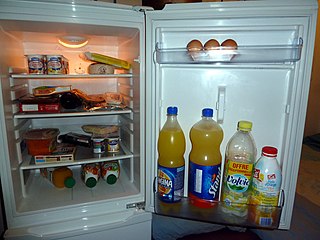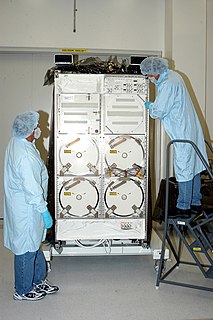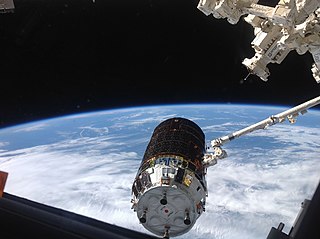
The International Space Station (ISS) is a space station, or a habitable artificial satellite, in low Earth orbit. Its first component was launched into orbit in 1998, with the first long-term residents arriving in November 2000. It has been inhabited continuously since that date. The last pressurised module was fitted in 2011, and an experimental inflatable space habitat was added in 2016. The station is expected to operate until 2030. Development and assembly of the station continues, with several new elements scheduled for launch in 2019. The ISS is the largest human-made body in low Earth orbit and can often be seen with the naked eye from Earth. The ISS consists of pressurised habitation modules, structural trusses, solar arrays, radiators, docking ports, experiment bays and robotic arms. ISS components have been launched by Russian Proton and Soyuz rockets and American Space Shuttles.

The Japanese Experiment Module (JEM), nicknamed Kibo, is a Japanese science module for the International Space Station (ISS) developed by JAXA. It is the largest single ISS module, and is attached to the Harmony module. The first two pieces of the module were launched on Space Shuttle missions STS-123 and STS-124. The third and final components were launched on STS-127.

Zvezda, DOS-8, also known as the Zvezda Service Module, is a component of the International Space Station (ISS). It was the third module launched to the station, and provides all of the station's life support systems, some of which are supplemented in the USOS, as well as living quarters for two crew members. It is the structural and functional center of the Russian portion of the station - the Russian Orbital Segment.

TransHab was a concept pursued by NASA in the 1990s to develop the technology for expandable habitats inflated by air in space. Specifically, TransHab was intended as a replacement for the already existing rigid International Space Station crew Habitation Module. When deflated, inflatable modules provide an 'easier to launch' compact form. When fully inflated, TransHab would expand to 8.2 meters in diameter.

STS-121 was a 2006 NASA Space Shuttle mission to the International Space Station (ISS) flown by Space Shuttle Discovery. The main purposes of the mission were to test new safety and repair techniques introduced following the Columbia disaster of February 2003 as well as to deliver supplies, equipment and European Space Agency (ESA) astronaut Thomas Reiter from Germany to the ISS.

The Destiny module, also known as the U.S. Lab, is the primary operating facility for U.S. research payloads aboard the International Space Station (ISS). It was berthed to the Unity module and activated over a period of five days in February, 2001. Destiny is NASA's first permanent operating orbital research station since Skylab was vacated in February 1974.

A refrigerator is a popular household appliance that consists of a thermally insulated compartment and a heat pump that transfers heat from the inside of the fridge to its external environment so that the inside of the fridge is cooled to a temperature below the ambient temperature of the room. Refrigeration is an essential food storage technique in developed countries. The lower temperature lowers the reproduction rate of bacteria, so the refrigerator reduces the rate of spoilage. A refrigerator maintains a temperature a few degrees above the freezing point of water. Optimum temperature range for perishable food storage is 3 to 5 °C. A similar device that maintains a temperature below the freezing point of water is called a freezer. The refrigerator replaced the icebox, which had been a common household appliance for almost a century and a half.
Kelvinator was a home appliance manufacturer that is now a brand name owned by Electrolux. It takes its name from William Thomson, 1st Baron Kelvin, who developed the concept of absolute zero and for whom the Kelvin temperature scale is named. The name was thought appropriate for a company that manufactured ice-boxes and domestic refrigerators.
Auto-defrost, automatic defrost or self-defrosting is a technique which regularly defrosts the evaporator in a refrigerator or freezer. Appliances using this technique are often called frost free, frostless or no-frost.

The Minus Eighty-Degree Laboratory Freezer for ISS (MELFI) is a European-built experiment storage freezer for the International Space Station. It comprises four independent dewars which can be set to operate at different temperatures. Currently temperatures of −80 °C, −26 °C, and +4 °C are used during on-orbit ISS operations. Both reagents and samples will be stored in the freezer. As well as storage the freezer is designed to be used to transport samples to and from the ISS in a temperature controlled environment. The total capacity of the unit is 300 litres.

The Lab-on-a-Chip Applications Development (LOCAD) element is a set of related lab-on-a-chip projects at NASA. The projects develop integrated lab-on-a-chip products in three areas related to space exploration: Environmental Control and Life Systems Support (ECLSS), Medical Systems, and Remote Exploration. NASA conducts activities related to these projects both at NASA Marshall Space Flight Center and aboard the International Space Station (ISS).
A freezer is a device similar to a refrigerator that maintains a temperature below the freezing point of water.

The International Space Station program is tied together by a complex set of legal, political and financial agreements between the fifteen nations involved in the project, governing ownership of the various components, rights to crewing and utilization, and responsibilities for crew rotation and station resupply. These agreements tie together the five space agencies and their respective International Space Station Programs and govern how they interact with each other on a daily basis to maintain station operations, from traffic control of spacecraft to and from the station, to utilization of space and crew time. In spring 2010, the International Space Station Program Managers from each of the five partner agencies were presented with Aviation Week's Laureate Award in the Space category, and NASA's International Space Station Program was awarded the 2009 Collier Trophy.

A solar-powered refrigerator is a refrigerator which runs on energy directly provided by sun, and may include photovoltaic or solar thermal energy.

NASA Astronaut Group 19. The group saw the training of two pilots, six mission specialists, three educator mission specialists to become NASA astronauts. These 11 astronauts began training in 2004. This was the last group to fly Space Shuttles.

Scientific research on the International Space Station is a collection of experiments that require one or more of the unusual conditions present in low Earth orbit. The primary fields of research include human research, space medicine, life sciences, physical sciences, astronomy and meteorology.The 2005 NASA Authorization Act designated the American segment of the International Space Station as a national laboratory with the goal of increasing the use of the ISS by other federal agencies and the private sector.

Kounotori 4, also known as HTV-4, was the fourth flight of the H-II Transfer Vehicle, an unmanned cargo spacecraft launched in August 2013 to resupply the International Space Station. It launched from Tanegashima Space Center aboard H-IIB rocket on August 3, 2013 and connected to ISS by August 9, 2013; it carried 5.4 tons of cargo. Kounotori 4 undocked on September 4, 2013 and was destroyed by reentry on 7 September 2013.
Microgravity Experiment Research Locker/Incubator (MERLIN) was designed by University of Alabama at Birmingham (UAB) Center for Biophysical Sciences and Engineering (CBSE) to operate as a hardmounted, single middeck locker equivalent within the ISS EXPRESS rack, the Space Shuttle, SpaceX Dragon, and Cygnus (spacecraft). It is used to provide a temperature controlled environment for scientific experiments between -20 °C and 48.5 °C. MERLIN is also used to Support Crew Galley Operations.
GLACIER was designed and developed by University of Alabama at Birmingham (UAB) Center for Biophysical Sciences and Engineering (CBSE) for NASA Cold Stowage. Glacier was originally designed for use on board the Space Shuttle, but is now used for storing scientific samples on ISS in the EXpedite the PRocessing of Experiments to Space Station (EXPRESS) rack, and transporting samples to/from orbit via the SpaceX Dragon or Cygnus spacecraft. GLACIER is a double middeck locker equivalent payload designed to provide thermal control between +4 °C and -160 °C.
Polar is a research refrigerator designed and developed by University of Alabama at Birmingham (UAB) Center for Biophysical Sciences and Engineering (CBSE) for NASA Cold Stowage. Polar was designed as a single mid-deck locker equivalent payload to store scientific samples on-board ISS and in transport to/from ISS via SpaceX Dragon or Cygnus spacecraft. Polar operates between 4 to −95 °C.
















